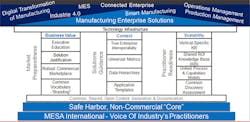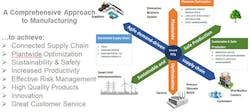Organizations that Help Manufacturers Understand and Implement Digital Technologies
Along with all the confusion around defining the future of manufacturing, with differing labels--digital and smart manufacturing; the Industrial Internet of Things and IoT; Industrie 4.0 and Manufacturing 4.0--comes a plethora of organizations that are trying to help manufacturers understand manufacturing's digital future.
But determining what each of the organizations offers can be almost as perplexing as sorting out the technologies.
That's why at the recent IndustryWeek Manufacturing & Technology Conference & Expo, the IW team hosted a panel discussion featuring three of the most prominent organizations dedicated to not only helping to develop and refine digital manufacturing technologies, but also to helping companies deploy them.
The three organizations included: the Digital Manufacturing Design and Innovation Institute (DMDII); the Smart Manufacturing Leadership Council (SMLC) and the Manufacturing Enterprise Solutions Association (MESA).
Mike Yost, President of MESA International
First up: Mike Yost, president of MESA International, explained the vision/mission of the organization, is to "build bridges of understanding from the plant to the enterprise (P2E) [in order to] drive clarity on the role and value of modern information technologies in production operations."
Noting that the organization has been serving manufacturers in this capacity since the early 1990s (when the mission referred to "the shop floor to the top floor integration"), Yost said, common problems they tackle often involve organizational and cultural issues, as well as the technological issues that impede effective deployment.
Organizationally, the group is designed to bring together all participants in the manufacturing space--manufacturers, consultants, solution providers, etc.--to work together on "areas that are important to them, whether from a geographic or 'problem spaces' perspective."
The groups leverage three avenues for collaboration:
- Peer-to-peer networking opportunities
- The creation and sharing of content, which is peer reviewed, non-commercial and focused on answering the questions the MESA membership asks. This content is also shared with non-members via the organizations "points-of-view" program.
- A formal education program
Ultimately, said Yost, directing attention to a graphical representation of MESA, and referring to the variety of manufacturing-of-the-future terms at the top of the image (below), "where ever you're trying to go as a business or whatever initiative you're trying to get behind, our focus is to help people prepare the market, to understand the market and the business value, as well as to produce solutions guidance and ready the practitioner space for using whatever [capabilities] future technologies hold."
Here's a video explaining MESA and its mission:
Mark Besser, Board Member, SMLC
Next up, Mark Besser an SMLC board member, described SMLC as "a group of a number of organizations that came together about six years ago, as a non-profit, with the goal of bringing accessibility to smart manufacturing and smart manufacturing systems to all organizations," no matter the size.
He noted about 50 organizations are represented in SMLC, including those from academia, industry and trade organizations, and research technology partners. The group holds meetings twice each year, which feature an "Industry Day" focusing in-depth on a particular topic, such as data visualization and contextualization. The Industry Day enables the group discuss advanced topics as they pertain specifically to manufacturing.
Pointing to a graphic in his presentation (below), Besser noted that the group's goal is to figure out "how do you bring traditional plant-wide operations and optimization of factory enterprise systems together with this notion of reaching deeper and farther out into the supply chain--and doing so in an agile environment; coordinating all that plant-wide connectivity, making that data visible to the organization and making it visible early in the process; and in a sustainable way from an energy-consumption perspective."
Ultimately, he added, the intent of the organization is to "solve problems around this notion of smart manufacturing" and to put the U.S. back in the lead of smart manufacturing.
Here's a video explaining SMLC and its mission:
Jacob Goodwin, Director of Membership Engagement & Communications, DMDII
DMDII, Goodwin explained, is one of the currently eight manufacturing institutes established and funded by the federal government under President Barack Obama's National Network for Manufacturing Innovation (NNMI). Each of the institutes within NNMI is charged with becoming a center of excellence, or a hub, around that particular niche of manufacturing. The institutes leverage federal funding to "draw some of the best talent from industry and academia in that niche, so that the individual centers of excellence, based in different geographical locations around the U.S., would once again make that particular niche predominant in the world."
DMDII, he notes, serves the digital manufacturing and design niche.
He described the institutes three essential missions, also illustrated below, as follows:
- To conceive and execute the definitive R&D program designed to push the field of knowledge in digital manufacturing and design forward. To this end, DMDII has 18 programs underway and intends to have a total of 50 programs in progress by year end.
- To extend within the U.S. or to reach out to companies in the U.S. to encourage them to adopt digital manufacturing and design technologies.
- To architect a nationwide program to train the workers of the future in what they need to know to implement these technologies.
Goodwin added that the institute works in three "realms," as follows:
- The digital thread, which connects together software and tools so the design stage can talk to the prototype stage
- Intelligent machining, which involves putting sensors on pieces of equipment in order to monitor performance in real time, and bring it back into spec if needed.
- Advanced Analytics, which includes capturing big data, crunching the data and deriving conclusions from it, and then leveraging it in the next design stage.
Here is a video explaining DMDII and its mission:
About the Author
Patricia Panchak
Patricia Panchak, Former Editor-in-Chief
Focus: Competitiveness & Public Policy
Call: 216-931-9252
Follow on Twitter: @PPanchakIW
In her commentary and reporting for IndustryWeek, Editor-in-Chief Patricia Panchak covers world-class manufacturing industry strategies, best practices and public policy issues that affect manufacturers’ competitiveness. She delivers news and analysis—and reports the trends--in tax, trade and labor policy; federal, state and local government agencies and programs; and judicial, executive and legislative actions. As well, she shares case studies about how manufacturing executives can capitalize on the latest best practices to cut costs, boost productivity and increase profits.
As editor, she directs the strategic development of all IW editorial products, including the magazine, IndustryWeek.com, research and information products, and executive conferences.
An award-winning editor, Panchak received the 2004 Jesse H. Neal Business Journalism Award for Signed Commentary and helped her staff earn the 2004 Neal Award for Subject-Related Series. She also has earned the American Business Media’s Midwest Award for Editorial Courage and Integrity.
Patricia holds bachelor’s degrees in Journalism and English from Bowling Green State University and a master’s degree in Journalism from Ohio University’s E.W. Scripps School of Journalism. She lives in Cleveland Hts., Ohio, with her family.






